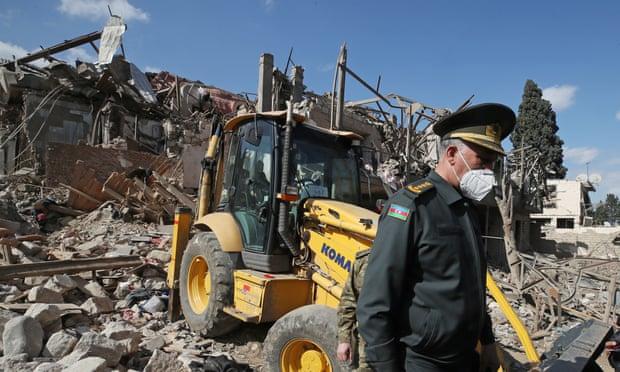Heavy shelling and civilian casualties dash hopes for Karabakh ceasefire
By Herve Bar and Dmitry Zaks
STEPANAKERT/GANJA – Hopes dwindled that a Russian-brokered ceasefire between Armenia and Azerbaijan might hold Sunday (11), with both sides accusing the other of intensive shelling of civilian areas and escalating two weeks of fierce clashes.
The two sides had agreed to pause hostilities to exchange prisoners and the bodies of people killed in two weeks of fighting over the disputed Nagorno-Karabakh region.
Azerbaijan’s foreign ministry said that overnight shelling by Armenian forces of the country’s second largest city, Ganja, had left at least seven people dead and 33 wounded including children, less than 24 hours after the halt to fighting was supposed to take effect.
Rescuers in red helmets dug through piles of debris with their bare hands looking for signs of survivors, an AFP journalist in the city reported.
They retrieved one nearly naked body and gingerly put it in a white bag to be taken away in an ambulance while several horrified residents watched on and wept.
One witness said they were woken by a huge blast that levelled an entire square block of one- and two-storey houses in the early hours of the morning, leaving nine apartments in ruins.
“Everything I’ve worked for my entire life has been destroyed,” said resident Zagit Aliyev, 68.
The truce negotiated in marathon Russia-brokered talks in Moscow officially entered into force at noon on Saturday (100, but both sides almost immediately accused each other of violations.
On Sunday, the Karabakh defence ministry insisted Armenian forces were respecting the humanitarian ceasefire, calling claims that Armenian forces were responsible for shelling Ganja “an absolute lie” and accusing Azerbaijan of shelling civilian-populated areas.
Armenia’s defence ministry said Sunday evening that the breakaway region’s defenders were responding “resolutely” as Azerbaijani forces were “undertaking assaults” with “armoured vehicles and missiles”.
Nagorno-Karabakh’s leader Arayik Harutyunyan described the situation as “calmer” on Sunday, but warned that the truce was precarious.
An AFP journalist in the administrative capital of Stepanakert, which has been subjected to heavy bombing since the fighting erupted and is pockmarked with deep craters and unexploded ordnance, reported hearing loud explosions throughout the night.
Vahram Poghosyan, a spokesman for Karabakh’s leader, said the overnight shelling of Stepanakert was “a disrespect of the agreements reached in Moscow,” and called on the international community to recognise Karabakh’s independence as a way to end the hostilities.
New fighting broke out late last month, stemming from a long-simmering disagreement between Armenia and Azerbaijan over the region.
The disputed territory is an ethnic Armenian enclave inside Azerbaijan, home to about 150,000 people, which broke from Baku’s control in a war in the 1990s that killed some 30,000 people.
Its separatist government is strongly backed — but not officially recognized as independent — by Armenia, which like Azerbaijan gained independence with the 1991 collapse of the Soviet Union.
The most recent bout of fighting has been the heaviest since the 1990s war, with more than 450 people reported dead, thousands forced to flee their homes.
Renewed fighting has stoked fears of a full-blown war embroiling Turkey, which strongly backs Azerbaijan, and Russia, which has a military treaty with Armenia.
Turkey’s defence ministry blamed Armenia for the ceasefire violations in a post on Twitter and accused Yerevan of committing “war crimes and crimes against humanity”.
Russian Foreign Minister Sergei Lavrov during a call with his Turkish counterpart Mevlut Cavusoglu on Sunday called for a “strict implementation” of the Moscow agreement.
Armenia and world leaders including Russian President Vladimir Putin and French President Emmanuel Macron have denounced the deployment of pro-Turkish fighters from Syria and Libya to bolster Azerbaijan’s army.
The defence ministry in Yerevan reposted an amateur video showing corpses in military fatigues and with the man behind the camera speaking in Arabic, claiming this was proof Syrian mercenaries were fighting with Baku’s forces.
France, Russia and the US – known as the ‘Minsk Group’ – have for decades sought a lasting solution to the Karabakh conflict, but have failed to stop sporadic outbreaks of fighting, and Baku with Turkey’s backing appears set on continuing with its military intervention.
Armenian Foreign Minister Zohrab Mnatsakanyan was to arrive in Moscow on Monday (12) for a visit including meetings with the Minsk Group co-chairs, his spokeswoman told AFP.
A senior Azerbaijani official said Saturday the truce was only meant to be “temporary,” and said Baku had “no intention to backtrack” on its effort to retake control of Karabakh.
The Pope on Sunday said he welcomed the ceasefire but deplored that “the truce proves to be too fragile.”
“I pray and invite you to pray for the victims and for all those whose life is in danger,” he said following the Angelus prayer in Rome.
– Agence France-Presse


